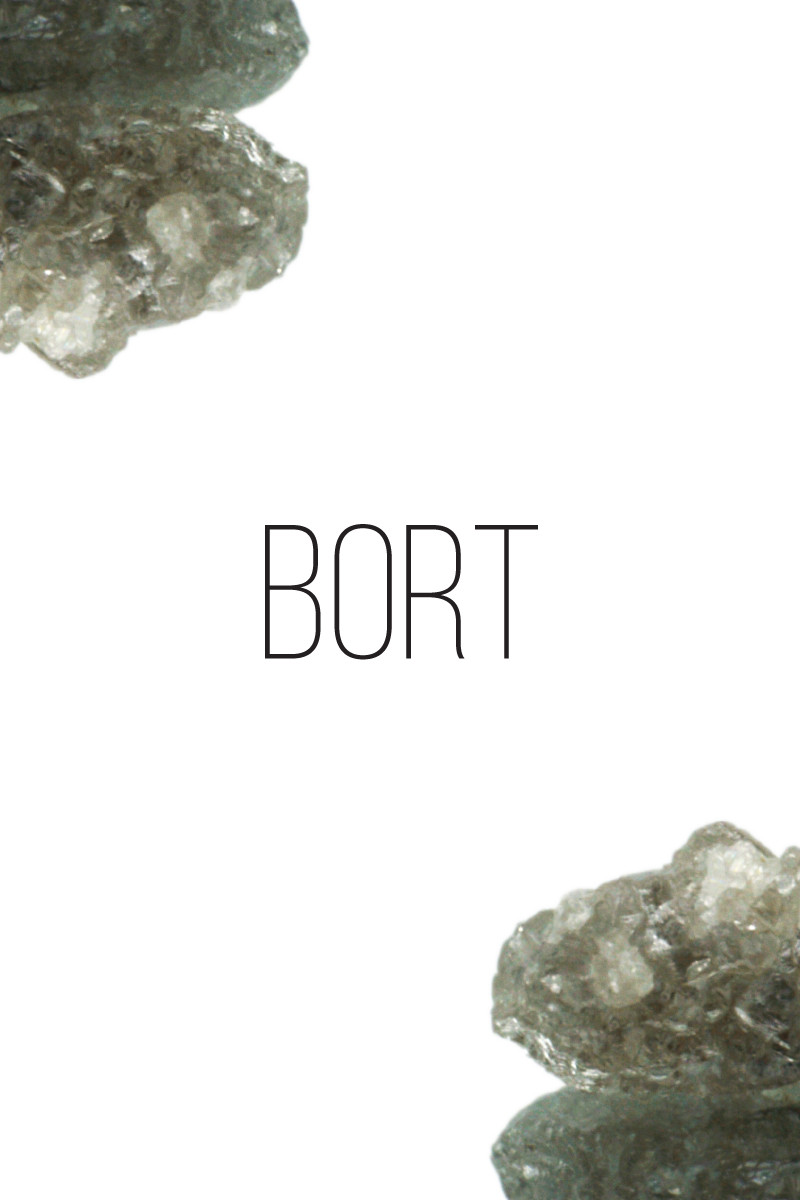
ボルト宝石:特性、意味、価値など
 ボルトは、宝石として使用できるほど高品質ではないダイヤモンドの一種です。その代わりに、宝石品質のダイヤモンドを加工するために、あるいは工業用途や宝石業界で使用されます。
ボルトは、宝石として使用できるほど高品質ではないダイヤモンドの一種です。その代わりに、宝石品質のダイヤモンドを加工するために、あるいは工業用途や宝石業界で使用されます。
では、ボルトはダイヤモンドの一種なのでしょうか?はい。ただし、ボルトは多くの場合、低品質のダイヤモンドの破片や粉末です。ほとんどのボルト結晶は暗く不透明です。
今日は、ボルトの硬度から歴史、特性、価格まで、この石について知っておくべきすべてのことを説明します。

ボットストーンについて
ボルト鉱物は、ボルト、ボアート、またはブーストと呼ばれることがあります。ボルトの一種の古い呼び名の一つにバラスがありますが、これはボルトまたはダイヤモンドの変種と見なされることもあります。ボルトの工業的な愛称には、「クラッシュダイヤモンド」や「工業用グレードダイヤモンド」などがあります。
ダイヤモンドは貴重な宝石なので、ボルトも貴重な宝石であると主張する人もいるでしょう。しかし、ダイヤモンドのように、宝石として利用されるボルトダイヤモンドジュエリーやファセットカットされたボルトストーンを市場で見かけることはほとんどありません。
とはいえ、ボルトとダイヤモンドは同じ素材なので、ボルトは4月の誕生石であり、牡羊座の星座石でもあります。占星術的には、ボルトは牡羊座特有の衝動性を抑え、精神的な明晰さを与えることで、同様に頑固な牡羊座を助けると言われています。
さらに、このダイヤモンドは、厳密には結婚60周年と75周年の記念宝石です。ダイヤモンドは伝統的に結婚75周年にのみ使用されていましたが、ヴィクトリア1世は1897年(即位60周年)に自身の「ダイヤモンド・ジュビリー」を記念して、結婚60周年にもダイヤモンドを使用しました。
結婚記念日以外のお祝いにも、ボートやダイヤモンドは使えますよ!メトロ・ゴールドウィン・メイヤー(MGM)は1984年に、ディズニーランドは2015年に導入しました。ぜひ試してみてくださいね!
ボルトは、実は現在世界で採掘されているダイヤモンドの中で最も一般的な種類であり、採掘されるダイヤモンド全体のおよそ 70 ~ 80 パーセントを占めています。
ボルトの産業用途
ボルトの主な用途は、宝石の切断と電動工具です。ダイヤモンドは最も硬い物質であるため、ボルトは他の宝石を傷つけ(そして研磨し)ます。そのため、ボルトは研削砥石に使用され、粉砕されて宝石のファセット研磨用の研磨剤となります。
より一般的な産業では、小さなボルト結晶はドリルビットや鋸などの切削機械に使用されています。これにより工具の刃先が保護され、寿命が長くなり、以下のような難削材を効率的に切削できるようになります。
鉄筋
セメント
石
コンクリート
金属
さらに、潤滑剤(パラフィン油など)に混ぜられた小さなボルト粒子は液体中に浮遊しないため、ボルト粒子を含まない液体の摩擦と比較して、液体の摩擦が最大 50 パーセント低下します。
「粉砕ボルト」とは、粉砕されて(衝撃的ですが)、研磨用のグリッツに使用されるボルトのことです。
工業用強度を考えると、ボルトはダイヤモンドよりも強いのでしょうか?ダイヤモンドとボルトの粘り強さ/靭性(破壊や割れに対する耐性)はどちらも脆いです。しかし、ダイヤモンドとは異なり、ボルトは完全な劈開を示さないため、強い衝撃を受けても簡単には割れません。
粘り強さのような性質といえば、ボルトの鉱物特性について議論しましょう。
 上の写真:鏡の上のダイヤモンドダスト|画像提供:Granger Meador、 Flickr
上の写真:鏡の上のダイヤモンドダスト|画像提供:Granger Meador、 Flickr
ボルトの仕様と特徴
まず、ボルトは何でできているのでしょうか?ダイヤモンドと同様に、ボルトは純粋な炭素でできており、そのシンプルな化学式はC(ご存知の通り、炭素)です。
ボートの色は?形状によって異なります。粉末状に砕いたものは、白から黄色になることが多いです。破片は黄色、茶色、黒色になることもあります。一般的に、ボートは灰色がかった色から黒っぽい色です。
ダイヤモンドが最も硬い鉱物であることを考えると、ボルトの硬度はどれくらいでしょうか?ボルトは通常、ダイヤモンドと同じ硬度(場合によってはわずかに低い)で、 モース硬度スケールでは10に相当します。
ボートの結晶化は、宝石に使用されない理由の一つです。ボートは放射状に結晶が成長することが多いため、宝石職人が研磨することができません。そのため、ほとんどのダイヤモンドは特徴的なアダマンチンのような輝きを出すために研磨する必要があるのに対し、ボートは脂っこい光沢を保っています。
さらに、ボートには通常、 内包物が多く含まれており、宝石としてはあまり魅力的ではありません。
以下は、ダイヤモンドとは若干異なる、Bort の鉱物データの残りです。
モース硬度:10
色: さまざま。粉末 - 白から黄色、破片 - 黄色、灰色、茶色、または黒
結晶構造:立方晶系だが、通常は不完全な結晶化である
光沢:脂っぽい
透明性:半透明から不透明
屈折率:
密度:3.5
胸の谷間:なしまたは乏しい
骨折:貝殻状
縞模様:無色
発光:蛍光とリン光あり - SW-UVおよびLW-UVでは青色
多色性:なし
ボルトの種類
ボートの唯一の変種はフレームサイトです。フレームサイトは南アフリカ産の黒いボートで、小さな輝く点が散りばめられています。これらの輝く点は何によるのでしょうか?100%明らかではありませんが、おそらくダイヤモンドの微細な内包物によるものと思われます。
ボートに関する議論でよく目にするもう 1 つのダイヤモンドの種類はカーボナードです。
 上の写真:Carbonado | 画像提供:James St. John | Creative Commons Attribution 2.0 Genericライセンス
上の写真:Carbonado | 画像提供:James St. John | Creative Commons Attribution 2.0 Genericライセンス
ボルト対カーボナド
宝石学者の中には、ボートとカーボナードを同義語と考える人もいますが、カーボナードは少し異なります。カーボナードは、樹脂のような光沢を持つ茶色、灰色、または黒色のダイヤモンドです。カーボナードを「ブラックダイヤモンド」と呼ぶ人もいます。
カーボナドは塊状で多結晶質であり、多数の結晶部分がランダムな方向に向いています。また、多孔質でもあります。
しかし、カーボナドとボルトはどちらも不透明で暗い色をしています。用途という点では、ボルトとカーボナドはドリルや研磨材として使用されるなど、工業用途では共通しています。
形而上学的な側面に移って、bott の精神的な意味が何をもたらすかを見てみましょう。
Bortの意味と歴史
ボルトはダイヤモンドと同じ象徴性を持ち、壊れることのない絆、誠実さ、そして永遠の愛を象徴しています。また、ボルトの精神的な意味は、強さ、成功、そして内面の美しさにも結びついています。
最初のダイヤモンドは古代インドからもたらされました。紀元前300年頃から約1000年間、インドは唯一のダイヤモンド産地でした。彼らはサンスクリット語でダイヤモンドを「ヴァジュラ」 (雷)と呼んでいました。地元の人々は、ダイヤモンドは嵐の神インドラ神が放った雷に打たれて形成されると信じていました。
古代インド人は、ダイヤモンドを宗教的、精神的な保護の目的で使用するだけでなく、ダイヤモンドの品質を評価する最初の価値評価ガイドであるヒンズー教の聖典「ガルーダ・プラーナ」も作成しました。
ボルトの起源
「ボート」という名称は1600年代初頭に遡り、オランダ語の「boort」に由来します。正確な起源や作者は不明ですが、1620年に登場しました。この語の翻訳は、フランス語の「 bort 」(ろくでなし)や、オランダ語の「ドリル」を意味する「 boort 」に由来している可能性があります。
もう一つの考えられる説明は、デンマーク語の「ボルト」の定義です。「一種のエッジまたはバンド」です。多くのボルトは、ダイヤモンドのファセット加工中に剥がれ落ちる欠けです。
古代ローマの学者大プリニウスの歴史書によると、ボルトは(その名前が使われるようになる前から)西暦 1 世紀にはすでに使用されていた可能性があるようです。
大プリニウスは著書『博物誌』第 3 巻でダイヤモンドについて次のように書いています。
「幸運にも[ダイヤモンド]が破損した場合、それはほとんど目に見えないほど微細な破片に分裂します。これらの粒子は彫刻師に非常に求められており、彼らはそれを鉄の中に閉じ込めます。これにより、知られている最も硬い物質でさえ、非常に容易に彫刻することが可能になります。」
 上の写真:シャロン平原とハイファ沿岸のパレスチナにあるユダヤ人の工場。テルアビブ。ダイヤモンド工場。ディスクにダイヤモンドダストを塗布する作業 | G. エリック&エディス・マトソン写真コレクション、米国議会図書館 | パブリックドメイン
上の写真:シャロン平原とハイファ沿岸のパレスチナにあるユダヤ人の工場。テルアビブ。ダイヤモンド工場。ディスクにダイヤモンドダストを塗布する作業 | G. エリック&エディス・マトソン写真コレクション、米国議会図書館 | パブリックドメイン
ダイヤモンドカットのBort
ダイヤモンドのカッティングは1300年代まで始まりませんでしたが、この時代は輝きを出すための表面研磨のみが行われていました。間もなく、インドの宝石職人がノミを用いた最初の本格的なダイヤモンドカッティング技術を開発しました。
1400年代、宝石職人たちはダイヤモンドの研磨にダイヤモンドダストを利用できることに気づきました。マリー・ド・ブルゴーニュは1477年、オーストリアのマクシミリアン大公から最初のダイヤモンドの婚約指輪を受け取りました。
1568 年にベンヴェヌート・チェッリーニが著作『金細工と彫刻に関するベンヴェヌート・チェッリーニの論文』の中で引用した言葉の一つに、ボルトを使った切削のプロセスの概要が述べられています。
ダイヤモンドは単独でカットすることは決してできません。非常に硬いため、必ず2つの石で同時にカットしなければなりません。他の石ではカットできません。ダイヤモンドがダイヤモンドをカットするのです。これは、熟練したカッターが望む形になるまで、ダイヤモンド同士をこすり合わせることで行われます。そして、その過程でダイヤモンドから落ちるダイヤモンドの粉末で、最終的な研磨が施されます。
やがて、産業革命と新たな技術の進歩により、ダイヤモンドはより精巧なファセットカットが可能になりました。市場と産業の拡大により、宝石以外の用途にも使用される切削工具など、ボルトの新たな用途が生まれました。
最近では、ポップカルチャーでも見かけるようになりました!
ポップカルチャーにおけるボルト
ポップカルチャーにおけるボルトへの最も頻繁な言及は、日本の漫画『宝石の国』です。ボルトはこのアニメの登場人物の一人です。他の主要人物と同様に、彼女も宝石でできた人型生物です。
劇中では、ボルトはダイヤモンド級の強さを持つ猛々しい戦士として描かれています。ボルトの髪の毛さえも、体内に眠る無数のダイヤモンド粒子を反映した、実在のダイヤモンドを彷彿とさせる無数の尾で構成されています。
性格的には、ボルトは陰気で真面目、そして奔放なタイプです。一方、ダイアモンドは明るく軽快で、お気楽なタイプです。キラキラと輝く大きなダイヤモンドの結晶で飾られたダイアモンドとは異なり、ボルトは小さなダイヤモンドの結晶で構成されています。そのため、ボルトはより少ないダメージでより強い攻撃に耐えることができます。
 画像クレジット: Rob Lavinsky、iRocks.com – CC-BY-SA-3.0
画像クレジット: Rob Lavinsky、iRocks.com – CC-BY-SA-3.0
ボルトの治癒特性
ダイヤモンドや他の宝石と同様に、ボルトはヒーリングストーンとして機能し、その力は色によって左右されます。ボルトは主に黒色であるため、他の黒色宝石と同様に、保護、グラウンディング、そして精神性への献身をもたらします。
一般的な白い宝石ダイヤモンドとは異なり、ボルトはルートチャクラ(ダイヤモンドのようにクラウンチャクラではなく)のチャクラストーンです。つまり、ボルトはこのチャクラを開き、安定、保護、そして安心感をもたらしてくれるのです。
チャクラヒーリング以外にも、ボルトの治癒力はダイヤモンドに似ています。その効果を以下で見ていきましょう!
身体の治癒
ボルトのようなダイヤモンドの品種は、中枢神経系(CNS)を治療し、認知能力を向上させると考えられています。また、ボルトは他のクリスタルの身体的治癒力を増強するためにも使用されます。
感情的な癒し
ボルトの感情的な癒しの効果には、ネガティブな感情や不安を払拭することが含まれます。また、この石は個人の成長を促し、自信と回復力を高める効果もあります。
成長といえば、ボルトはどのように形成されるのでしょうか?
ボルトの形成と供給源
ボルトは、地球の地下約100マイル(マントル層)で、ダイヤモンドと同じプロセスを経て形成されます。地下の炭素鉱床は、極めて高い圧力と高温にさらされ、最終的に結晶化します。このプロセスには数日、数ヶ月、あるいは数百万年かかることもあります。
鉱夫たちは、宝石質のダイヤモンドの他に、主にキンバーライト岩石やその近くの沖積鉱床でボートを発見します。キンバーライトには、ガーネット、方解石、カンラン石、輝石などの鉱物も含まれています。
採掘場所
現在、ボルトのような工業用ダイヤモンドの主な生産国は南アフリカとブラジルです。その他の重要な産地としては、コンゴ、インドネシア、ロシアが挙げられます。
 上の写真: ダイヤモンド研磨機 |画像クレジット: wim hoppenbrouwers、 Flickr
上の写真: ダイヤモンド研磨機 |画像クレジット: wim hoppenbrouwers、 Flickr
ボットジェムの価格と価値
ご想像のとおり、ボートの価格は宝石品質のダイヤモンドの価格よりも大幅に低くなっています。工業用グレードのボート原石は、通常1カラットあたり約3.50ドルです。個々のボート原石は、ほとんどが1カラットあたり約0.50ドルです。
合成ボルトパウダーは通常、1カラットあたり約0.50ドル以下です。天然ボルトパウダーはわずかに高く、1カラットあたり1~2ドルです。ダイヤモンドカット用の合成ボルトは通常、1カラットあたり0.25~2.50ドルです。
Bort の防塵コーティングされたのこぎりの価格はおよそ 2 ドルからで、より頑丈な機器の価格は 25 ドルから 500 ドル以上にもなります。
Bort で精神的なサポートを見つけましょう!
ボルトという名前は少々耳障りかもしれませんが、何十年にもわたり、多くの新婦の指を美しく飾る、愛すべきダイヤモンドを生み出す貴重な素材です。ダイヤモンドの採掘量の大部分を占めるにもかかわらず、ボルトは裏方でしっかりと存在感を示し、仕事への満足感を得るためには、畏敬の念を抱く必要はないということを私たちに思い出させてくれます。
宝石のカットについてさらに詳しく知りたい場合は、 基本的なツールと宝石細工の基礎に関するガイドをご覧ください。
Gemstone Encyclopedia検索
最新記事
レインボーラティスサンストーンは、様々な内包物によって3つのゴージャスな光学的効果を持つ長石の一種です。燃えるように鮮やかな色合いと格子模様が、コレクターにとって希少な宝石となっています。
12th Jan 2026
チューライトは、ゾイサイト鉱物ファミリーに属する、鮮やかなバラ色の色合いを示す希少なノルウェー産の宝石で、ジュエリーのセッティングやペンダントによく使用されます。
6th Jan 2026
記事のカテゴリ
How To's is where you will find helpful articles from gem Rock Auctions on how to cut gemstones, select gemstones and buy gemstones.
9記事数
